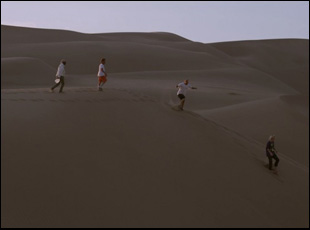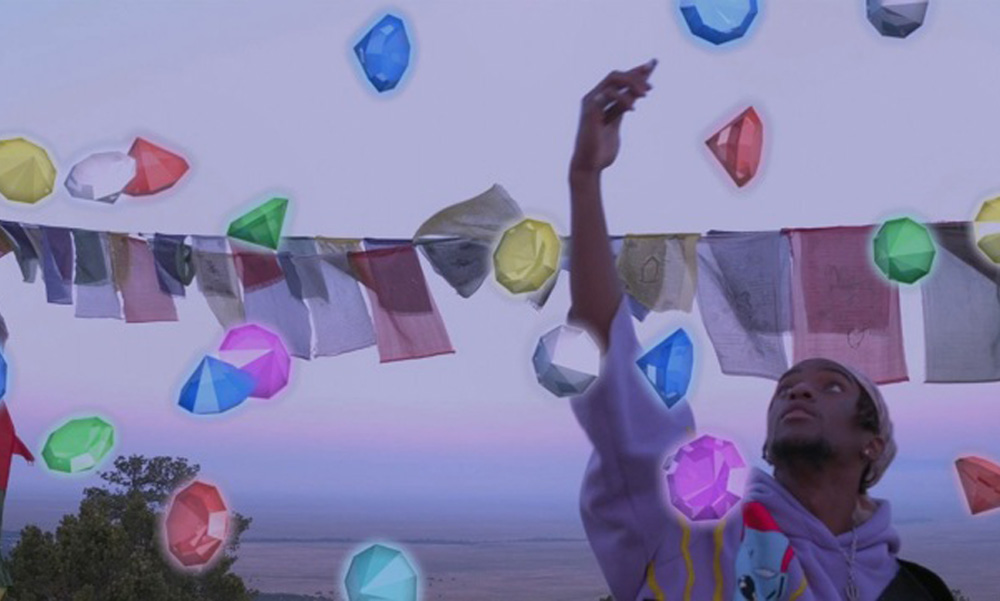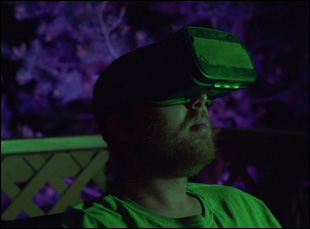Virtual reality is often thought of in digital terms, but at the heart of “Crestone” is the provocative notion that rather than escaping into a world that’s been built from pixels and data bytes, what if it were just as easy to start curating your experience in real life as it is to edit your profile on social media? It’s how Marnie Ellen Hertzler found herself amongst a group of nomads in the furthest reaches of the Colorado desert, making sandwiches out of whatever items are around and spending nights recording music to upload on Soundcloud. They have internet access, but with land for miles outside their cabin that has gone untended, it would seem as if the world is theirs without any societal pressure to conform, leaving the group led by a rascal known as Sloppy, to decide what that looks like for themselves.
While the group of guys that Hertzler embeds with can only figure this out as they go along, the intrepid filmmaker has shown a unique talent for bringing audiences into places that are perhaps familiar or unassuming but radically reshaped by changes in our interaction with them, illuminating the points where there’s an emotionally tactile experience when there’s seemingly nothing to hold onto, either because it exists exclusively in an online world or for the fact of what that cultural shift has taken away from engagement in physical realm. After shorts including “Dirt Daughter,” “Hi I Need to Be Loved” and “The Domestic Life of a Housecat,” where mixed media has helped the filmmaker pulls these liminal spaces into sharp relief, “Crestone” marks an epic feature debut, one in which you can lose yourself quite easily in a haze of pot smoke, the serene natural landscapes or the ethereal score provided by the Animal Collective, yet in going off the grid, one can reflect on the world that’s immediately around us wherever that may be and consider both our own power to shape it and the external forces we have no control over.
Shortly after the film’s premiere last year at the True/False Festival where the film would make its one and only physical festival appearance before the threat of the coronavirus pushed everything online, Hertzler spoke about how she was drawn to this band of outsiders and giving shape to their experience, as well as being influenced by her own online practices to find the right way to tell this story.
I went to high school with a lot of the guys in this movie in Raleigh, North Carolina, and my very best friend, the guy who gets the tattoo in the beginning, I’ve been in touch with for probably more than any other friend in my entire life. There’s just been this really powerful longevity in our relationship and I was noticing for the past few years how his online presence and his friends’ has changed has changed into something I find so exciting and entertaining. He was traveling back and forth to Crestone to stay with this guy Sloppy and hang out with his friends, so I wanted the opportunity to just visit other friends, but also I thought it would be fun for us all to go out there and make a movie together, so that’s how it all started. I had enough money to go out there and shoot for eight days, so that’s what we did. [laughs]
Did you have any expectations for these eight days?
Part of keeping my relationship healthy with these guys is eliminating any expectations. [laughs] And I think that’s safe to do with anyone. People can change and not to expect too much from anyone other than kindness and love, so that’s all I really did expect. We had some scenes scripted talking back and forth with everyone and I had some ideas about the locations, just for Googling what’s around there and just hearing stories from the guys. I knew we would go out there and I would come home with at least a couple music videos, and maybe a short film, but when we got back, we decided to push it into feature-length just to see what happens.
This strange brotherhood that they have was really what inspired me and I don’t really think when we see images of people that look like them. It is such a driving force behind their creativity and just the act of staying alive, so capturing that was really important. That’s so special and I keep getting the question, “Are there any women that live in Crestone?” And it’s like yes, of course, there are women that live in Crestone, but this is about brotherhood. This is about fraternity and to be honest, I was keeping this world post-apocalyptic, so I didn’t want to have that option of procreation. I wanted them to be the last humans alive on earth, so their love had to be expressed through masculine love and brotherhood and support.
It seems to fit snugly into your body of work where the digital world and reality interact.
Yeah, I do use digital space a lot in my work because I do think I rely heavily on it in my life for communication and for friendships, so out there when there is such a void of digital space, my natural inclination was to bring that space back in. I used the visuals that were naturally occurring in Crestone, like the waterfall and the cave and the dunes and the expansive sky and just brought it into my digital safety zone.
It was intriguing to hear that you and your cinematographer Corey Hughes wanted to give your cameras different personalities.
Yeah, Corey and I love personifying our equipment. It’s important to assign characters to cameras because in so much of my work, my camera is present and digital and physical, so the drone was representative of Ben, his eye in the sky and the Osmo camera was like this strange liminal digital alien space that just roamed around with him, and then Corey’s main camera, the more cinematic FS7 was just another one of the friends out there, like a little too stoned —just observing and following along behind them and getting too close at some times and having to step back. I thought to have the cameras also exist in the subjective realm was important as opposed to taking a purely observational role.

It did actually. There was a wildfire that started a few towns over by arson. Some crazy guy just set his property on fire and there were some tensions in the town already. As the eight days progressed, the fire got closer and closer to the point where we could see the smoke rising above the other side of the mountain range, and it got scary at one point because I was worried that we’d get stuck there. People in the town were starting to evacuate, so there was a moment where we were all deciding, should we just call it and drive to Denver and stay safe? We just decided to push through. There were only a couple days left and I thought, well, if anything, we’ll just film the fire and the smoke, the ingredients to any movie.
That period in the film actually leads to one of my favorite lines in the movie, which is “You realize creativity is a denial of reality.” Did you actually know you’d be incorporating a voiceover from the start?
I didn’t have plans at all for how anything was going to be edited. There were a few cuts where my voice wasn’t present at all and I had to ask myself a couple of times, “Is this the movie that I really want to make?” What happened is randomly one night I watched Agnes Varda’s “The Gleaners and I,” and the way she uses her voice in that movie, it almost becomes part of the landscape. I wanted to give it a try because so much of my experience of it was what was happening inside my own head, and once I brought my voice into the movie reluctantly, I was surprised that it did bring an extra dimension and more life to the movie. It began to become a movie that I felt like I would make.
You’ve mentioned how you wanted to structure the film in a similar way as information traveled on social media. What was it like figuring out how to tell this story?
If anything, that style is most familiar to me. I’m just most comfortable with the endless scroll and flipping between images and sometimes these images connect and sometimes they don’t. A lot of us exist in that plane right now, so editing the movie with Albert Birney, I had collected social media videos — and there’s some in the movie, but there’s a whole backlog of them — and it was flipping through my archive, adding it in as we’re flipping through the landscapes of Crestone. It was actually a natural way of working for me.
What was it like to work with Animal Collective on the score?
It’s always been a dream to work with them. I’ve been an Animal Collective fan since I was 14 years old, but I met Deakin when I was living in New Orleans. He was a neighbor and he showed up to a hot dog party I was having at my house and we became friends then. We just happened to move to Baltimore at the same time and stayed in touch and were always looking for an opportunity to work together and I thought this was the perfect one. I thought their music was so good at describing landscape and creating a world within sound, so it was great working with them. Brian [Weitz] and Josh [Dibb] are just the most unbelievable musicians and just really understand cinematic language and visuals, so was really exciting.
These are strange times, but what’s it like putting this out into the world?
I didn’t expect I’d have to put it out in this way, but I think it’s a really nice way for this film to be presented. People are watching it alone in their rooms on a computer and I actually think that’s a pretty appropriate platform right now. The movie is so tied to the internet, so streaming it makes sense, but also watching it in isolation also makes sense. People have been reaching out feeling a sense of camaraderie with these guys and with me even because they are experiencing the same kind of isolation and the same kind of doom anxiety, so it has been interesting rather than sitting in the theater full of people going about their daily lives. It’s been a happy path for this movie. No complaints. I’m very privileged to be even making films in the first place and really privileged for people to be taking time out of their day to watch my movie.
“Crestone” is now available to rent on Apple TV and Amazon Prime Video.





